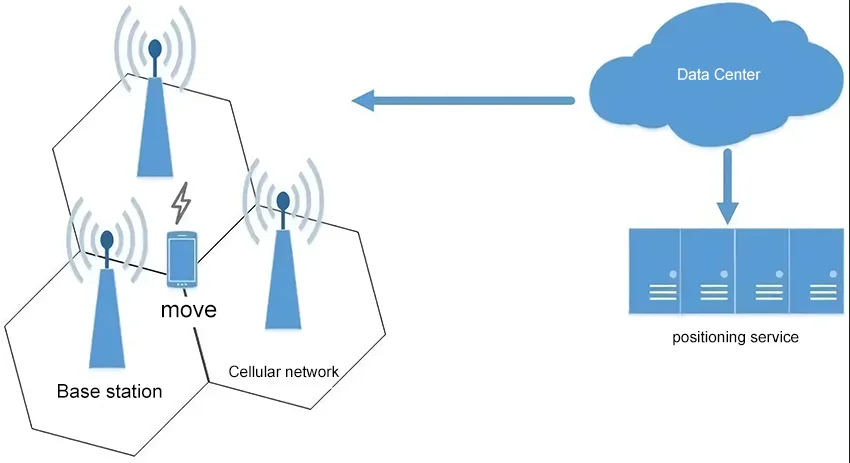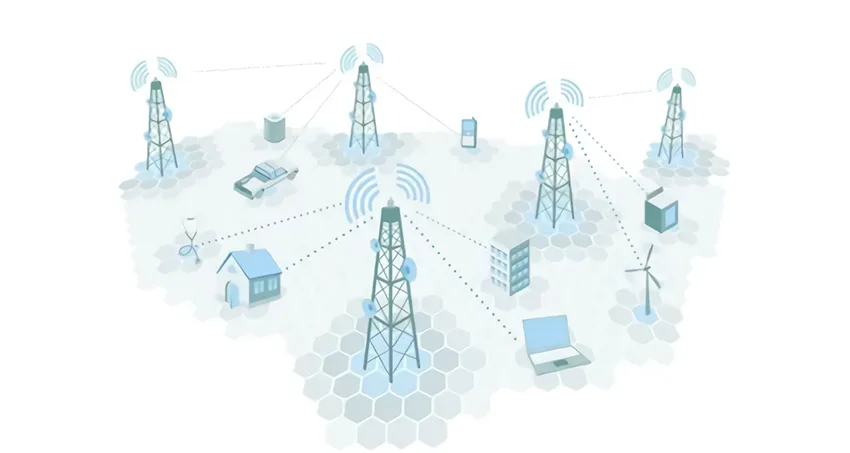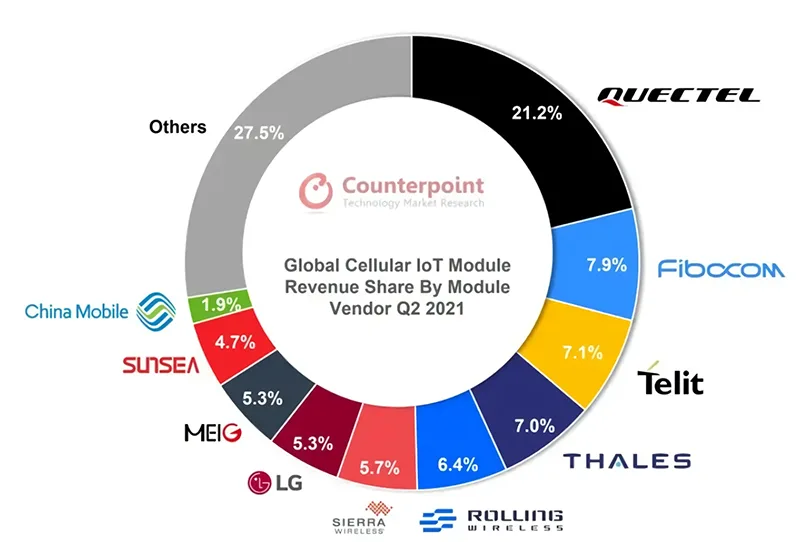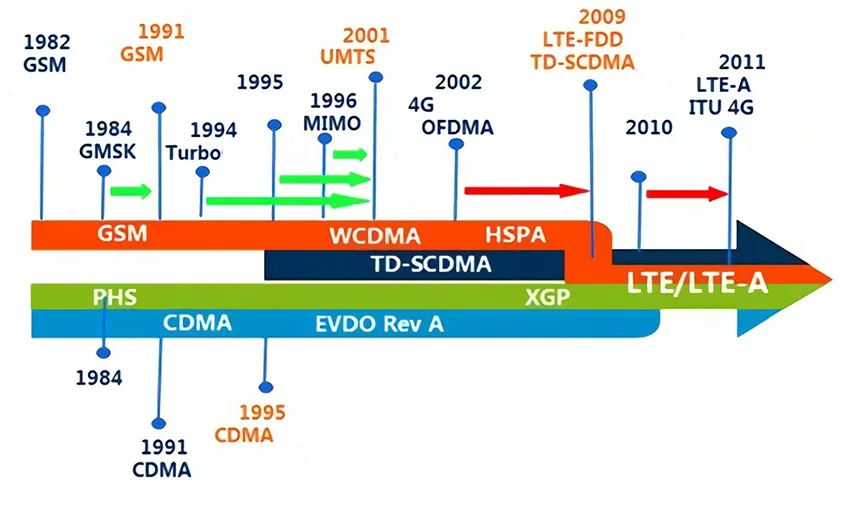行動網路是蜂窩網路的別稱, 屬於行動通訊硬體架構. 它分為兩種類型: 模擬蜂窩網絡和數位蜂窩網絡. 因為構成網路覆蓋範圍的各個通訊基地台的訊號覆蓋範圍是六邊形的, 整個網路就像一個細胞, 所以它被這樣命名.
1. 什麼是蜂窩網絡?

蜂窩網絡包括三個部分: 移動站, 基地台子系統與網路子系統. 他們之中, 行動站是網路終端設備, 例如我們的手機; 數位設備, ETC。, 可以看作是無線網路和有線網路之間的轉換器.
常用的蜂窩行動通訊採用蜂窩無線組網方式, 透過無線通道連接終端和網路設備, 從而實現用戶之間的相互交流. 其域特徵是終端的移動性. 其功能是跨本地網路切換和自動漫遊. 隨著各種通訊技術的發展, 一些報告預測蜂窩設備的數量將達到 350 未來萬, 特別是透過訪問的蜂窩設備 LTE 和5G. 在這樣的情況下, 迫切需要更有效率的蜂窩設備測試.
2. 蜂窩技術如何運作

這 蜂窩電話系統 用於在行動站和公用電話系統之間建立連接, 或另一個蜂窩系統的移動站之間的另一個連接.
行動站和蜂窩網路之間的資訊透過無線電波傳輸, 無需傳統電話中的電話線, 以便行動用戶可以自由移動, 例如, 在車上, 或步行.
3. 為什麼稱為蜂窩網絡?

蜂窩是無線通訊技術. 該技術將一個地理區域劃分為多個小區, 稱為“蜂窩” (即細胞); 因此, 這項技術因此而得名, 細胞的. 智慧型手機 (或手機) 使用這種技術,因此通常被稱為蜂窩電話. 透過將一個巨大的地理區域劃分為多個小區,可以充分利用有限的無線傳輸頻率. 每組連接 (或者, 對於無線電話, 每組會話) 需要專用頻率, 雖然只有大約 1000 所有可用頻率. 讓更多對話能夠同時進行, 蜂窩系統為每個「小區」分配一定數量的頻率 (IE, 每個小區域). 不同小區可以達到並啟動相同的頻率; 所以, 有限的無線資源可以充分的應用與利用. 全球行動通訊系統 (全球行動通訊系統) 和碼分多址(碼分多址) 是常見且常見的蜂窩系統. 它們是第二代通訊技術.
4. 蜂窩網路包含哪些無線技術?

空間調變技術
在無線通訊蜂窩技術中, 採用空間調變方法,讓無線網路天線佈局更科學合理. 空間調變本身是一種資訊技術,透過將網路資料與天線位置相關聯來增強網路傳輸效能.
大規模天線技術
大規模天線技術, 在無線網路蜂窩技術中, 透過天線固化設施形成可發射和接收的傳輸通道. 作為基於電子技術的組件類型, 天線本身可以實現無線訊號的傳輸功能. 通訊網路中大規模天線技術的使用可以為蜂窩系統的整體組成奠定基礎.
無線網路技術
無線電是網路的基礎. 在無線網路技術的應用中, 透過無線電頻譜可以形成高效率的傳輸通道. 在廣播網路中, 可以辨識網路使用者的使用需求, 然後可以為使用者自主分配合適的網路頻道. 當某個頻段被佔用時, 使用者的網路使用需求將被拒絕, 其他頻段將取代.
4.1 什麼是1G技術?
1G基本上是第一代行動通訊技術 (1G). 在此之上, 它通常指的是原始模擬, 僅語音蜂窩電話標準. 它是在20世紀80年代開發的. 北歐行動電話 (神經機器翻譯) 就是這樣一個標準. 已應用於東歐, 俄羅斯, 和北歐國家. 其他包含高級行動電話系統 (AMPS) 位於美國, 全接入通訊系統 (塔塔控制系統) 位於英國, JTAGS 在日本運營, 在西德工作的 C-Netz, 收音機與 2000 在法國, 和 RTMI 首次在義大利提供服務. 在很多地方, 模擬蜂窩服務正在慢慢被淘汰。
4.2 什麼是2G技術?
2G代表行動通訊領域的第二代技術. GSM 就是一個例子. 該技術的核心是數位語音的傳輸. GSM 是一個標準 1992 由歐洲標準化委員會. 採用數位通訊技術和統一的網路標準. 透過做, 確保通訊品質和為用戶開發新服務. GSM行動通訊網路的傳輸速度為 9.6 千/秒. 現在, 有超過 500 全球 100 萬 GSM 行動用戶, 覆蓋 1/12 人口的, 而GSM技術佔了超過 70% 全球數位手機領域. GSM是與類比行動通訊技術相關的技術.
4.3 什麼是3G技術?
3G代表第三代技術. 和前幾代相比 (1G和2G) GSM 的, 碼分多址, 和其他類型的數位行動電話.
一般來說, 3G是指無線通訊與多媒體通訊結合的新一代行動通訊系統, 網路就是一個典型的例子. 可處理各類媒體形式,提供各類資訊服務. 形式可以是音樂, 視訊串流, 或圖片, 而服務可以是電話會議, 網頁瀏覽, 和電子商務. 提供此類服務, 無線網路必須能夠支援不同的資料傳輸速度, 即, 2 Mbps 和 384 各環境中的 kbps, 例如房間內部, 建築物外, 以及在移動環境中. 另外, 傳輸速度是 144 kbps。
4.4 什麼是4G技術?
4G科技在科技領域與第四代行動通訊存在差距. 是3G與WLAN結合的科技產品. 可以傳輸高品質的視訊影像, 影像傳輸品質相當於高畫質電視.
4G行動通訊技術的根本目的是向終端產品的另一端發送和接收訊號, 並找到不同網路系統之間最快、最有效的通訊路徑, 平台, 和無線通訊介面以最快的傳輸速度, 接收和定位動作.
4.5 什麼是5G技術?
5G 第五代行動通訊技術簡介. 這是最新一代. 它也是前幾代系統的擴展, 如4G. 韓國三星電子公司。, 有限公司. 率先研發成功第五代行動通訊技術 2013 並於去年開始將其商業化.
4.6 什麼是6G技術?
6G是5G的擴展, 這是第六代行動通訊標準. 也稱為第六代行動通訊技術. 主要推動因素是物聯網的成長. 6G基地台可同時連接數百個以上無線連接. 這些車站容量達到 1,000 5G基地台的倍數.
5. 蜂窩網路技術的安全

無線蜂窩網路在提升無線網路覆蓋範圍方面發揮重要作用. 在寬頻無線城域網路中, 網狀結構可實現大面積覆蓋,低成本、高效率. 網狀結構有許多優點,例如在網路無法保證通訊順暢的情況下提供有效的迂迴路由. 比專線或菊花鏈更靈活、更可靠, 且網路具有自配置能力, 自組織, 和自我修復。
無線網路長期以來一直採用集中控制模式, 這也帶來了傳輸瓶頸等潛在風險, 遺留系統, 或單點故障. 儘管如此, 無線網路正在成為另一種無線交換技術. 蜂窩網路可以透過有組織的方式將情報從交換機分發到接入點 網狀拓撲.
由於蜂窩網路依賴管理, 控制, 和資訊的發現, 他們必須保護自己的流量和使用者的流量. 帶內資訊透過加密隧道傳輸, 可以防止竊聽或類似的攻擊. 基於標準的安全技術, 例如 802.1x, 以及高級加密標準等加密技術, 確保只有授權的無線網路設備和節點才能連接並正確加密.
6. 蜂窩網路技術的市場是什麼?

對位研究, 世界知名研究機構, 發布全球蜂窩物聯網模組最新預測: 到2030年代, 全球手機出貨量 物聯網 模組將超過 1.2 十億, 年複合成長率為百分之十二. 出貨量的成長將主要由第五代驅動, 窄帶物聯網, 和第四代貓 1 雙技術. 之間 2022 和 2030, 5G技術將是成長最快的技術, 其次是4G貓 1 雙技術.
同時, 根據研究公司瞻博網路發布的報告, 蜂窩物聯網市場規模將達到 31 十億美元 2022, 並由 2026, 蜂窩物聯網市場規模將超過 61 十億美元!
7. 蜂窩技術的歷史

自從蜂窩行動通訊發展以來, 大約每十年就會完成一項具有里程碑意義的技術創新, 經歷了從語音業務到高速寬頻數據業務的跨越式發展. 20世紀80年代初, 第一代行動通訊系統, 蜂窩行動電話系統, 出生了. 1G行動通訊系統引進了蜂窩網路的概念 (即細胞系統) 首次, 實現頻譜資源的空分複用, 並採用頻分多址 (頻分多址) 提高系統容量的技術.
在 1991, 第二代行動通訊系統或數位行動通訊技術應運而生. 2G行動通訊系統採用TDMA和CDMA技術 (時分多址 \ 碼分多址). 系統採用數位調變技術. 其係統容量, 保密性, 語音通話品質大幅提升, 取得了巨大的商業成功.
隨著網路的發展, 數據和多媒體業務快速發展. 在 2001, 以數位多媒體行動通訊為目的的第三代行動通訊系統進入商用階段. 3G行動通訊系統採用更先進的寬頻CDMA技術,使用更大的系統頻寬在更高頻段進行資料傳輸, 使其資料傳輸速率進一步提高. 其主要代表為CDMA 2000 在北美, 寬頻碼分多址 (寬頻碼分多址) 歐洲和日本提出的行動通訊系統, 和時分同步碼分多址 (TD-SCDMA)) 中國的技術.
在 2011, 3GPP發布第四代行動通訊系統寬頻數據行動互聯網通訊技術. 4G行動通訊系統基於扁平化網路架構設計,並在3G長期演進的基礎上進行升級 (LTE). LTE系統採用的關鍵技術, 如正交頻分多址, 航空醫學中心, 和多輸入多輸出, 被LTE系統採用 (這些縮寫代表正交頻分多址, 自適應調變和編碼, 以及多輸入多輸出). 頻譜效率提高, 上下行峰值速率達到50Mbps/100Mbps.
與前幾代技術僅提供人與人之間的寬頻行動通訊不同, 5G, 作為適應人類資訊社會需求的行動通訊系統 2020, 將滲透到物聯網等領域, 並將與工業設施密切相關, 醫療設備, 運輸. 它帶來了深入, 全面落實萬物互聯平等參與. 有效滿足垂直產業資訊服務需求. 運輸, 產業, 和醫療保健是滿足需求的例子. 除了支持傳統的人與人之間的交流, 它還將支援大規模機器類型通信, 成為推動國家經濟社會發展、推動產業轉型升級的重要動力. 全世界, 湧現一批組織和機構積極進行5G研究工作.















